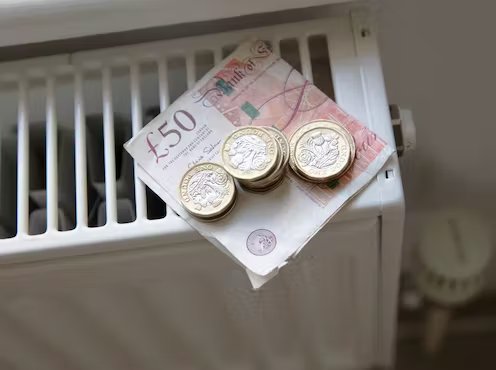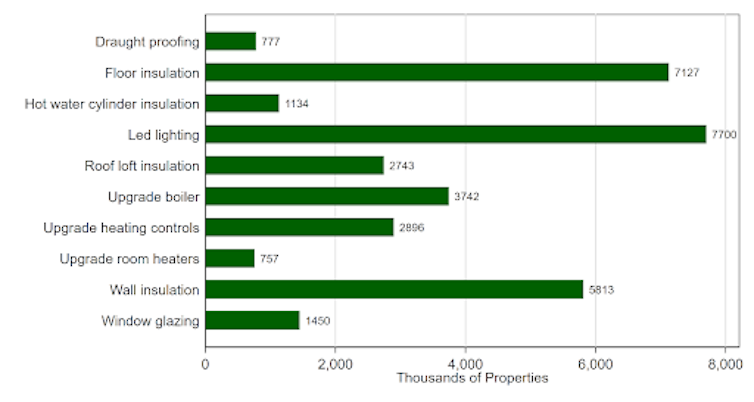The cost of electricity rose sixfold between January 2021 and November 2022 as the impact of the COVID pandemic combined with Russia’s invasion of Ukraine to push up wholesale energy prices.
Without government intervention, household electricity costs could have grown sixfold too. But the energy price guarantee (EPG) launched in September 2022 was designed to limit the per-unit price charged to all consumers.
Under the scheme, a typical customer should pay around £2,500 per year (£3,000 from April 2023), according to government estimates. The government then compensates suppliers for the difference between the per-unit cost they face to buy energy and the maximum they can charge to customers. But this is a costly burden and the public funds used to do this could be deployed to support households in better ways.
When discussing energy, there are also environmental considerations, of course. Heating and lighting UK homes account for almost a fifth of the country’s greenhouse gas emissions. And efforts to reduce these emissions are moving far too slowly. According to government data, the residential sector, alongside agriculture, has the worst record for reducing carbon emissions over the last 30 years.
And with governments becoming increasingly aware of the need to tackle this problem, wholesale energy prices will probably remain high as more taxes on carbon emissions are introduced globally. But until emission taxes become a reality, it could be more effective to overhaul energy policy to pursue two main aims:
- supporting energy-poor households in weathering the energy crisis, and
- supporting the government’s ambitious net-zero strategy, which includes a target of installing 600,000 heat pumps by 2028.
Meeting these goals will take a new approach, both to energy support and to how the government deploys its transition strategies, including more local and regional collaboration.
A broader support system
While the EPG is a step towards the first goal, it ignores the second. Indeed, the analysis I conducted with my colleagues at the University of Warwick highlights that the EPG has regressive effects. It reduces energy costs for families with high incomes and high usage.
At 2022 market prices (represented by the dashed blue line in the chart below) an increase in energy use leads to a pronounced increase in annual bills. Under the EPG (the solid orange line) bills increase less sharply as usage goes up. This means that super-consumers will benefit most from the EPG.
Within the roughly 280,000 UK households with an annual income over £150,000, around 14,000 consume more than twice as much energy as nearly 50% of all other households in this high-income group.
Rising energy costs versus consumption
Estimated increase in energy bills with electricity at market prices and under the EPG. Ofgem, Department for Levelling Up, Housing & Communities, Author provided
A lack of focus on energy efficiency investments is also an issue in national energy policy. And confusing short-lived policies, lengthy paperwork and late reimbursements can mean programmes fail to fully spend budgets.
This can trigger a termination of a scheme until a new one is drafted, leaving customers to wonder whether energy efficiency investments are worthwhile if the government cannot make up its mind about what to provide. For example, the plateauing of solar panel installations has been linked to the halving of the government’s renewable energy feed-in-tariff scheme in 2012.
Conversations with local councils during our research into this issue have also highlighted that despite more closely understanding the needs of the population, local councils feel underfunded and under-supported to help with the transition to net zero. And national government programmes sometimes miss important segments of the rural, rental, and middle-income population, for example.
A broader and more coherent strategy is needed, under which the national government works with local authorities. Our research shows that 10.9 million properties in England alone could benefit from energy efficiency investments in terms of reduced energy use, reduced energy bills, and reduced carbon emissions.
Indeed, the next graph shows that at least 5.8 million properties would benefit from improved wall insulation such as solid or cavity wall insulation, 2.8 million properties would benefit from roof or loft insulation and 7.1 million properties could benefit from floor insulation. Further, there are at least 3.7 million properties that could benefit from condensing boiler upgrades.
Residential energy efficiency improvements
Number of properties with estimated potential for energy efficiency improvements (thousands). Department for Levelling Up, Housing & Communities, Author provided
Helping at many levels
But how can these investments be made, while still supporting families who struggle to pay their bills? Replacing the EPG with a more progressive price structure that keeps revenues neutral would be a solid first step. Our research suggests that a two-tier tariff could better target energy use subsidies towards low-income households with low energy use while charging market rates for high users who can afford to pay higher rates and invest in energy efficiency.
And if receiving a large bill still does not encourage families to use less energy, a renewed push to encourage smart meter uptake could help people plan their energy use. This could also open up new opportunities for conservation and demand management, as my upcoming research on water conservation in the US shows.
Community-level strategies could also help the government support households on their journey towards energy efficiency. Research in this area shows that firsthand experience and word of mouth can go a long way to convincing people to adopt green investments. Neighbours joining forces might help reduce contractor costs.
It will take a joint effort, at all levels of government, to reach net zero without leaving the most vulnerable behind. At the local level, organisations with strong community ties, such as faith-based groups, could help restore trust in energy policies that have flip-flopped too often in the past. Local councils are well-positioned to identify these pockets of trust and bring them to fruition. Only by recognising the role of these forces can national policy succeed in tackling this challenge.



 Asian Currencies Steady as Rupee Hits Record Low Amid Fed Rate Cut Bets
Asian Currencies Steady as Rupee Hits Record Low Amid Fed Rate Cut Bets  Debunking myths about community housing: What governments and the public should know
Debunking myths about community housing: What governments and the public should know  Our housing system is broken and the poorest Australians are being hardest hit
Our housing system is broken and the poorest Australians are being hardest hit  UK cities need greener new builds – and more of them
UK cities need greener new builds – and more of them  Sharehousing can be fun, but fraught with risk – and the law offers little protection. These 3 changes could help
Sharehousing can be fun, but fraught with risk – and the law offers little protection. These 3 changes could help  From NIMBY to YIMBY: How localized real estate investment trusts can help address Canada’s housing crisis
From NIMBY to YIMBY: How localized real estate investment trusts can help address Canada’s housing crisis  Stamp duty is holding us back from moving homes – we’ve worked out how much
Stamp duty is holding us back from moving homes – we’ve worked out how much  Tech Stocks Lift S&P 500 as Fed Rate-Cut Expectations Rise
Tech Stocks Lift S&P 500 as Fed Rate-Cut Expectations Rise  Asian Markets Mixed as Fed Rate Cut Bets Grow and Japan’s Nikkei Leads Gains
Asian Markets Mixed as Fed Rate Cut Bets Grow and Japan’s Nikkei Leads Gains  RBA Signals Possible Rate Implications as Inflation Proves More Persistent
RBA Signals Possible Rate Implications as Inflation Proves More Persistent  How a hybrid heating system could lower your bills and shrink your carbon footprint
How a hybrid heating system could lower your bills and shrink your carbon footprint  Australia’s Economic Growth Slows in Q3 Despite Strong Investment Activity
Australia’s Economic Growth Slows in Q3 Despite Strong Investment Activity  Oil Prices Slip as Russia-Ukraine Peace Hopes Fade and Oversupply Fears Grow
Oil Prices Slip as Russia-Ukraine Peace Hopes Fade and Oversupply Fears Grow 






























